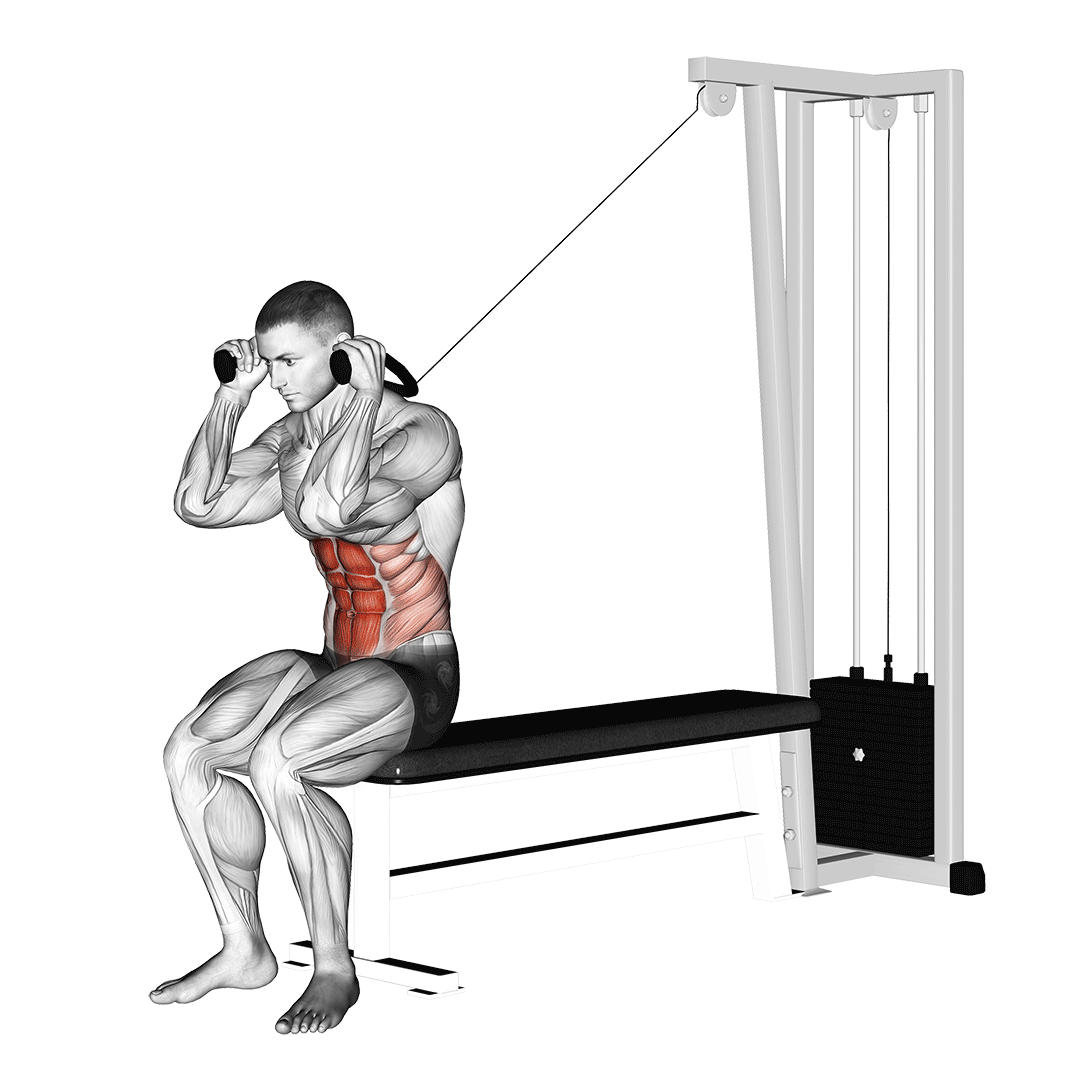The Cable Seated Crunch is an effective exercise to enhance core strength and sculpt your abs. This exercise engages your abdominal muscles with added resistance, essential for not only developing impressive abs but also strengthening your core for overall stability and improved functional movement.
Targeting the rectus abdominis, or the six-pack muscle, the Cable Seated Crunch also activates the obliques for effective twisting and lateral movement. Integrating this into your routine enhances posture and boosts performance in other workouts. Aim for two to three sessions weekly, prioritizing proper recovery between workouts in a controlled environment, preferably at a gym with cable machines to ensure optimal form.
To perform the Cable Seated Crunch, sit with feet flat and knees bent, using a low cable pulley. Engage your core, lean back, and exhale as you pull the handle downward, rounding your back. Hold the contraction before inhaling as you slowly return to the start. Maintain control throughout to maximize effectiveness and reduce the risk of injury. If a cable machine isn’t available, resistance bands offer a similar alternative, making this versatile exercise accessible for all fitness levels. With dedication and the right technique, you’ll work towards achieving a strong, sculpted core.
How to Do a Cable Seated Crunch

Start by sitting on a bench with your feet flat on the floor and your knees bent. Adjust the cable pulley to a low position and grasp the handle with both hands, keeping your elbows bent and arms close to your head.
- Engage your core and lean back slightly, creating tension in the cable.
- Exhale as you contract your abs, pulling the handle down towards your knees while rounding your back.
- Hold the contraction for a moment at the bottom of the movement.
- Inhale as you slowly return to the starting position, maintaining control over the cable.
Focus on exhaling during the contraction and inhaling as you return to the starting position for optimal breathing.
Level Up Your Fitness: Join our 💪 strong community in Fitness Volt Newsletter. Get daily inspiration, expert-backed workouts, nutrition tips, the latest in strength sports, and the support you need to reach your goals. Subscribe for free!
Level Up Your Fitness: Join our 💪 strong community in Fitness Volt Newsletter. Get daily inspiration, expert-backed workouts, nutrition tips, the latest in strength sports, and the support you need to reach your goals. Subscribe for free!
Common Mistakes
- Poor Posture: Slouching can lead to back strain. Maintain a straight back and engage your core throughout the exercise.
- Rushing the Movement: Performing the crunch too quickly can sacrifice form. Move slowly and with control to ensure a full range of motion.
- Neglecting Breathing Patterns: Forgetting to exhale during the contraction can reduce effectiveness. Exhale forcefully when crunching down and inhale steadily while returning to the starting position.
- Using Excessive Weight: Too much weight can lead to improper form. Start with a manageable weight to ensure correct performance before increasing the load.
- Not Engaging the Core Fully: Failing to activate your abdominal muscles limits results. Concentrate on core engagement to maximize muscle activation.
Benefits of the Cable Seated Crunch
- Enhanced Core Strength: Targets the rectus abdominis, obliques, and transverse abdominis, leading to improved overall core strength essential for better stability and balance.
- Improved Functional Movement: Enhances functional movement patterns, translating to better performance in daily activities and sports, reducing the risk of injuries.
- Increased Muscle Activation: The resistance provided by the cable promotes greater muscle activation compared to traditional crunches, leading to superior muscle hypertrophy and strength gains.
- Enhanced Posture and Spinal Health: Reinforces good posture by developing strong back and abdominal muscles that support the spine during various activities.
- Flexibility in Training: Easily adjustable resistance makes it suitable for all fitness levels, allowing for progressive overload and continuous improvement.
Exercise Variations
Alternative Exercises
Safety Precautions
Performing the Cable Seated Crunch requires careful attention to safety and form to avoid injury and maximize effectiveness. Before starting, ensure your workout area is clear of obstructions and the cable machine is functioning properly. Adjust the cable pulley to a suitable position for your height and reach. Check that the handle is securely attached to prevent any sudden releases during the exercise. Wear supportive footwear and comfortable athletic clothing to enhance your range of motion and reduce the risk of slips or falls.
When executing the exercise, proper form is crucial. Sit with your back firmly against the bench and keep your feet flat on the floor to establish a stable base. Avoid leaning back too far to prevent unnecessary strain on your lower back. Keep your elbows bent and close to your head to focus tension on your abdominal muscles instead of your arms. During the contraction, round your back as you pull the handle down, but avoid overextending or jerking the movement, which can lead to injury. Always return to the starting position with control to prevent the cable from snapping back.
If you have lower back injuries, abdominal trauma, or experience severe discomfort during crunch-like movements, consult with a healthcare professional before performing this exercise. Modifications such as reducing the weight or performing the movement with less range of motion can make it more manageable. Listening to your body and adjusting your approach are keys to safely transforming your abs.
Final Thoughts
The Cable Seated Crunch is a versatile and effective exercise for strengthening your core and sculpting your abs. By incorporating this movement into your fitness routine and focusing on proper form, you can enhance your posture, improve functional movements, and achieve a strong, defined core. Remember to start with manageable weights, prioritize safety, and stay consistent to maximize your results.
Interested in measuring your progress? Check out our strength standards for Crunches.








